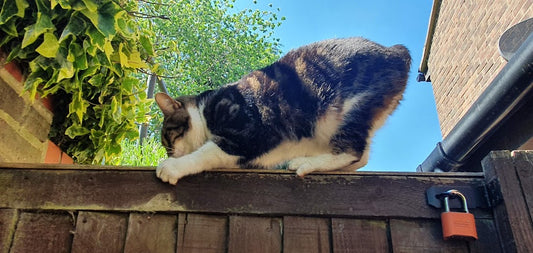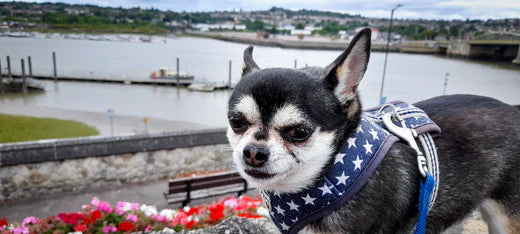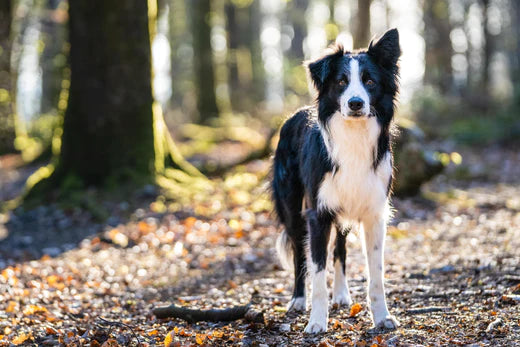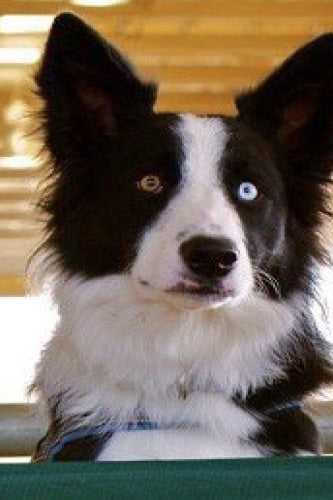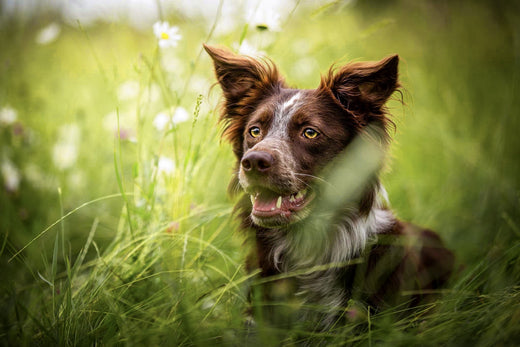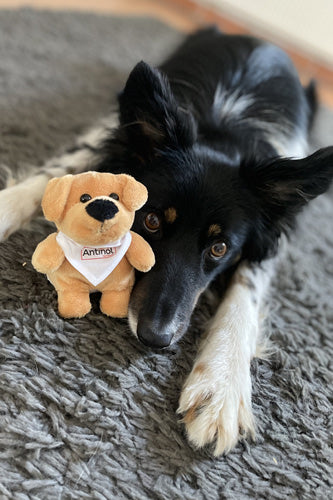A couple of weeks ago whilst the team were at Goodwoof, I met the most beautiful dog - a giant white Pyrenees with the most lovely temperament. Aside from being possibly one of the most magnificent dogs I’ve ever had the pleasure of giving a nose stroke, he was also one of the most memorable. Due to an accident, he was a dog whose tail had lost it’s wag.
As I crouched down and gave this giant hound a cuddle, I listened to the sadness in his owner’s voice as he told all about the ‘tail that doesn’t wag’ with equal sorrow. Later that night watching my Poppy bouncing across the room, tail going faster than windscreen wipers on full, I got curious about why a dog wags their tail and what it means. Understanding the language of dog tail wagging is like unlocking the secret language to a dog’s emotions and intentions. While many of us believe a wagging tail is a canine way of saying ‘I’m Happy,' the truth it turns out, is far more complex and involved.
For instance, did you know that puppies don't come into the world wagging their tails. This physical movement typically only starts to develop when they reach three to four weeks of age. However, they don’t learn it from other animals, it’s an innate behaviour encoded in their DNA. It’s actually their number one communication tool both to other dogs and to us humans. While it’s commonly thought that dogs wag their tail to show they are happy, interestingly, it can be for many other reasons as diverse as nervousness, fear, anger, and excitement.
The shape, size, and movement of the tail varies between breeds and also between individuals of the same breed. Golden retrievers tend to have large, expressive tails that sway from side to side when they walk, whereas breeds like Whippets and Greyhounds tend to carry their thinner tails at a lower than average mast. And Spitz breeds such as Huskies and Malamutes have tails that curl backward, with some even touching the dog's back.
Despite these differences in tail characteristics, most dogs can still understand and effectively communicate with each other when properly socialised. A wag to the right means something different to a wag to the left, and the speed the tail wags means something entirely different altogether. As we look into the quirky world of tail talk we can better understand what our canine companions are really feeling, enabling us to strengthen those bonds even further with our canine besties.

The Evolution of the Tail Wag
In the 1800s, Charles Darwin observed unique traits in domesticated animals compared to their wild counterparts, including docility, floppy ears, white fur patches, curly tails, and smaller heads and snouts. This cluster of characteristics, known as "domestication syndrome,” also included enthusiastic tail wagging which has lead to the ‘domesticated rhythmic wagging' hypothesis.
Tail wagging is a regular, rhythmic behaviour and studies show that humans release the love hormone, oxytocin when they see rhythmic patterns. This release of feel good hormones may explain why humans tended to favour dogs that wag their tails rhythmically and therefore why we see it in domesticated pets.
Mastering the Basics of Tail Talk

It's important to understand the fundamentals of tail talk - a dog's tail can convey a wide range of feelings, from excitement and happiness to fear, aggression, and anxiety. Position, speed, and environment are all crucial parts of the tail wag to understand the full picture of what’s going on.
Tail Position
The height at which a dog holds its tail can offer insights into its confidence and temperament.
- High and Stiff: Alertness or Aggression - A dog's tail held high and rigid, sometimes with quick movements, often signals an alert or aggressive state This stance is taken when a dog is asserting dominance or confronting a threat and ready for action.
- Neutral Position: Calm and Relaxed - A neutral position aligned with its spine usually reflects calm and contentment. Use this as a reference to assessing their other emotional states.
- Low or Tucked: Anxiety or Fear - A tail positioned lower than the neutral stance or tucked beneath its body indicates feelings of anxiety, fear, or submission. In this posture, dogs are not a threat and are telling you they feel insecure.

Wagging Speed
The pace of a dog's tail wagging can reveal the intensity of its emotions.
- Quick Wagging: Excitement or Happiness - Rapid, energetic wags are used for greetings, this type of wagging typically signifies a high level of happiness or excitement upon seeing you. It's a very cheerful canine greeting.
- Slow Wagging: Uncertainty - Gentle measured wags may suggest that a dog is feeling unsure or cautious in a particular situation. They are processing their emotions and assessing their surroundings.
- Circular Wagging: Utter Joy - Circular or helicopter wags happen when a dog ’is extremely happy or playful. It's seen as a really positive indicator, reflecting their total joy or excitement in a situation.
Wagging Direction
Recent studies indicate that the direction of tail wagging can also convey a variety of emotions.
- Wagging to the Right - Signifies positive emotions, indicating the dog's comfort and happiness in the current situation or with the person they're engaging with.
- Wagging to the left - Suggests negative emotions, signaling the dog's desire to move away from a certain situation.
Interestingly, a study conducted in 2013 revealed that dogs interpret the direction of a tail wag in other dogs. This study involved 43 pet dogs of various breeds.
Researchers showed these dogs videos of other dogs wagging their tails in both right and left directions, while monitoring their heart rates. When the dogs were presented with a video of a dog wagging its tail to the right, most of them remained relaxed, with some even showing signs of wanting to approach the dog on the screen. Conversely, when the dogs were shown a video of a leftward tail wag, they exhibited symptoms of anxiety, and their heart rates actually increased.
Keep in mind that the context/environment also plays a role when trying to interpret a wagging tail. To truly understand your dog's emotional state, it's essential to take into account where they are and what’s around them, as well as their overall body language, including facial expressions and posture, along with their tail wagging. This comprehensive approach will provide a more accurate depiction of how your dog is feeling.

Tail Talk is only part of the picture
While tail wagging is related to communication, the tail serves many other practical purposes too. According to Dr. Lisa Radosata of Florida Veterinary Behaviour Service, a dog's tail acts as a rudder during swimming and plays a crucial role in maintaining balance while running, enabling them to make sharp turns without losing their footing. In the past, many owners and breeders opted to dock their dogs' tails for cosmetic reasons.
However, this practice is now prohibited in the UK due to its unnecessary nature and potential impact on a dog's communication abilities and balance. As you can see the seemingly simple act of tail wagging is key to the human-canine bond, unlocking communication between dog and their human.
So next time your pup wags their tail at you, along with it invoking a smile take a moment to understand what it represents— the very best in canine communication.


